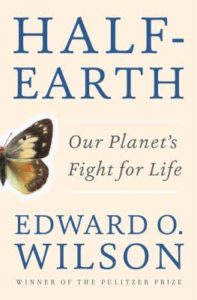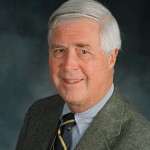 Edward O. Wilson, the remarkable professor emeritus at Harvard, who is known for his studies of ants, for the third time asks, “Who are we?” His first question was partially answered in The Social Conquest of Earth (2012) in which he analyzed the confusion of human existence, as our convoluted and introspective species tries to come to grips with our brief existence. Two years later, in The Meaning of Human Existence (2104), he described how, either deliberately or inadvertently, we are destroying other species even as we begin to recognize that we depend on them as much as they depend on us.
Edward O. Wilson, the remarkable professor emeritus at Harvard, who is known for his studies of ants, for the third time asks, “Who are we?” His first question was partially answered in The Social Conquest of Earth (2012) in which he analyzed the confusion of human existence, as our convoluted and introspective species tries to come to grips with our brief existence. Two years later, in The Meaning of Human Existence (2104), he described how, either deliberately or inadvertently, we are destroying other species even as we begin to recognize that we depend on them as much as they depend on us.
Now, concluding his trilogy, Wilson suggests a possible plan of action for homo sapiens. He continues his habit of short, punchy chapters, only one of 20 pages and most of 10 or less, even one of three. Instead of plunging into more verbiage, the reader must pause and think. His thesis: in order to survive we must commit “half of the planet’s surface to nature” in order to save “the immensity of life forms that compose it,” including us. A tall order, but is it possible?
Wilson begins with this earth’s extensive history of life extinctions. We’re lucky to be here! Should we worry? After all, the oldest major “extinction event,” at the end of the Ordovician period, happened some 455 million years ago and the most recent was a mere 66 million years back, when an enormous asteroid crunched into the Yucatan. Are we now coming close to a “Sixth Extinction”, the end of the current Anthropocene Era, as so clearly described by Elizabeth Kolbert in her The Sixth Extinction (2014)? Both Kolbert and Wilson recite alarming facts, plus suppositions, about our human relationships with other living creatures, large and small, on this earth. Are we the ultimate problem? They seem to think so.
To begin, “our population is too large for safety and comfort.” It is time to reduce, not expand, our footprint. “The biosphere does not belong to us; we belong to it.” But to acknowledge that, we must “… find our way as quickly as possible out of the fever swamp of dogmatic religious belief and inept philosophical thought.” We still understand too little about other species: some two million are “known” but there are perhaps some five to 100 million yet to be discovered. It is this enormous biodiversity that is the strength of this planet.
What then to do? Wilson suggests “… in order to save biodiversity it is necessary to understand how species interact with one another to form ecosystems.” But our enormous egos (and religions) tell us we are “Number One” when we are actually a small part of the action. His Solution: “Increase the area of inviolable natural resources to half the Earth or greater.” This will require a “fundamental shift in moral reasoning concerning our relation to the living environment.” We must “reduce the amount of space required to meet all the needs of an average person … habitation, fresh water, food production and delivery, personal transportation, communication, governance, other public functions (i.e. education), medical support, burial, and entertainment.” And note that this “average person” now lives in Asia and Africa as well as Europe and North America, with enormous current differences.
How will this take place? Here in Lyme, our Lyme Land Conservation Trust (www.lymelandtrust.org) has preserved in some fashion 3,000 acres of land and water resources in our small town. It and comparable efforts in this country and around the world are effective bottom-up programs. But Professor Wilson argues that these are not enough: we will need top-down guidance plus massive re-education for everyone. Is this economically possible? Do we have a choice?
Professor Wilson is obviously an optimist: “So we stumble forward in hopeful chaos.” Elizabeth Kolbert had her own conclusion: “The history of life consists of long periods of boredom interrupted occasionally by panic.”
Half-Earth and its sister volumes should be required reading for all of us. Perhaps we can wake up and change.
Editor’s Note: ‘Half-Earth: Our Planet’s Fight for Life’ by Edward O. Wilson is published by W. W. Norton, New York 2016.
 About the Author: Felix Kloman is a sailor, rower, husband, father, grandfather, retired management consultant and, above all, a curious reader and writer. He’s explored how we as human beings and organizations respond to ever-present uncertainty in two books, ‘Mumpsimus Revisited’ (2005) and ‘The Fantods of Risk’ (2008). A 20-year resident of Lyme, he now writes book reviews, mostly of non-fiction that explores our minds, our behavior, our politics and our history. But he does throw in a novel here and there. For more than 50 years, he’s put together the 17 syllables that comprise haiku, the traditional Japanese poetry, and now serves as the self-appointed “poet laureate” of Ashlawn Farms Coffee, where he may be seen on Friday mornings. His wife, Ann, is also a writer, but of mystery novels, all of which begin in a bubbling village in midcoast Maine, strangely reminiscent of the town she and her husband visit every summer.
About the Author: Felix Kloman is a sailor, rower, husband, father, grandfather, retired management consultant and, above all, a curious reader and writer. He’s explored how we as human beings and organizations respond to ever-present uncertainty in two books, ‘Mumpsimus Revisited’ (2005) and ‘The Fantods of Risk’ (2008). A 20-year resident of Lyme, he now writes book reviews, mostly of non-fiction that explores our minds, our behavior, our politics and our history. But he does throw in a novel here and there. For more than 50 years, he’s put together the 17 syllables that comprise haiku, the traditional Japanese poetry, and now serves as the self-appointed “poet laureate” of Ashlawn Farms Coffee, where he may be seen on Friday mornings. His wife, Ann, is also a writer, but of mystery novels, all of which begin in a bubbling village in midcoast Maine, strangely reminiscent of the town she and her husband visit every summer.